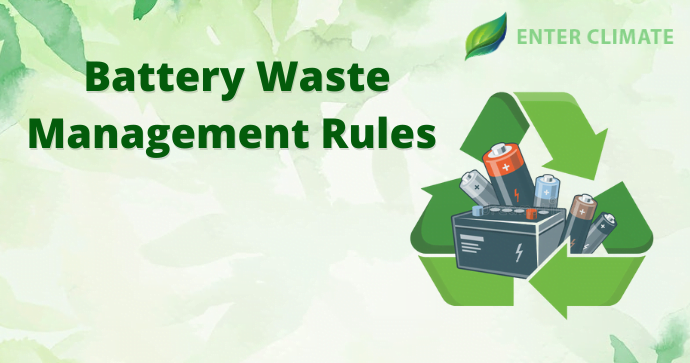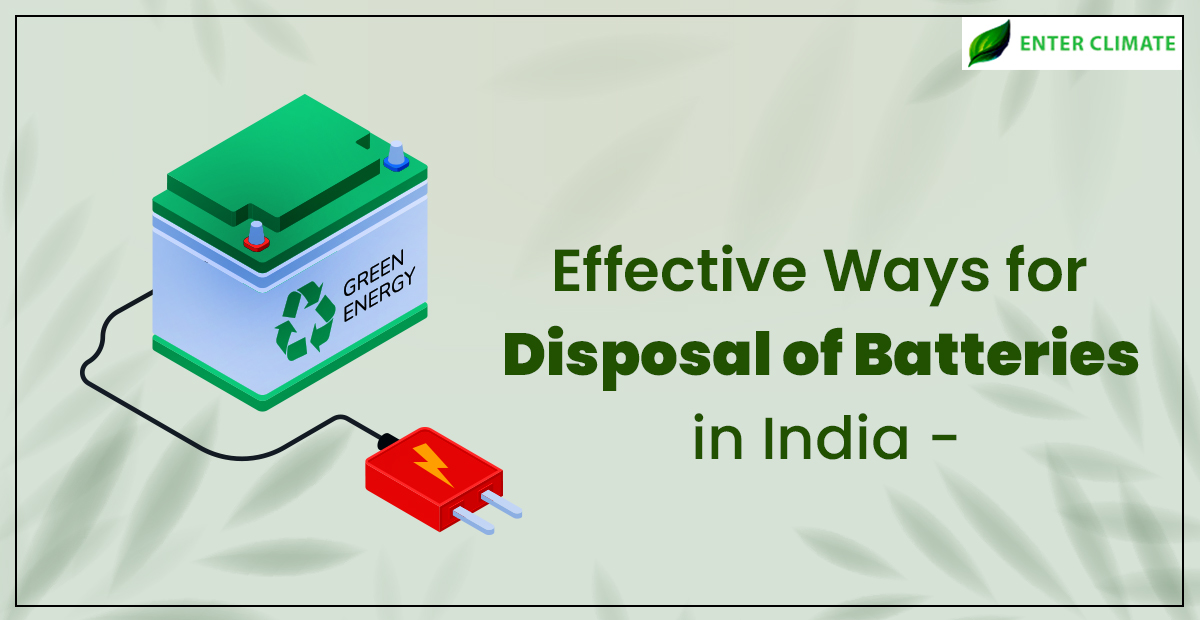Complete Overview of Battery Waste Management Rules, 2022
 29 Sep, 2023
29 Sep, 2023 
The rapidly growing use of electric vehicles and solar power plants. electronic devices and industrial batteries have led to a complicated situation of handling different hazardous components in the waste created by these batteries. This situation was not anticipated when the Battery Waste (Management and Handling) Rules 2001 came into effect and therefore called for a revision of the rules. New technologies for rechargeable secondary batteries like Electric Vehicle batteries, portable batteries, automotive batteries and industrial batteries have been made. The government, through the Battery Waste Management Rules, 2022, has introduced Extended Producer Responsibility (EPR) for producers similar to the responsibilities of PIBOs in e-waste recycling. The 2022 rules fixed the gaps in the 2001 version of the rule by defining many missing terms related to battery waste management which have been dealt with throughout this article. The highlight of the new rule is the introduction of electric vehicle batteries, and the other is the introduction of Extended Producer Responsibility. The Rules now lay down the collection and recycling targets for the producers (including importers) of batteries, who have now been made responsible for the collection, recycling and refurbishment of the waste batteries and the use of recovered materials from wastes into new batteries. Though the rules allow for the creation of separate entities that can manage the collection, recycling or refurbishing under the extended producer responsibility of the producers, the obligations of meeting the EPR targets will, however, remain with the producers only.
Changes brought by the Battery Waste Management Rules, 2022
Key terms and sections added: The new Rules defines term related to the battery like Automotive battery, battery pack, End of Life battery, used battery, waste battery etc. The rules clearly mention the prohibitions and labelling requirements for batteries in schedule I, while schedule II mentions the targets for Extended Producer Responsibility comprehensively.
Broadening the definition of manufacturer into producer: The 2001 rule has defined ‘manufacturers’ as the entities involved in the production of batteries. Now under the Battery Waste Management Rules, 2022, the term ‘producer’ has been introduced. The term now encompasses entities involved in the manufacture, sale or import of new or refurbished Batteries (even if included in any equipment) under their own brand name or procured and sold under their own name will be considered producers.
Introduction of Extended Producer Responsibility: The management of end-of-life batteries will now be done along the lines of Extended Producer Responsibility, on which the management of e-waste and plastic waste was done.
Centralised Online Portal for Registration: The rules will enable the setting up of a mechanism and centralised online portal by CPCB. Registration and filing of returns by producers, recyclers and refurbishers of waste batteries and exchange of EPR certificates between producers and recyclers/refurbishers will be made possible through this portal.
Functions and Responsibilities of Stakeholders under Battery Waste Management Rules, 2022
The Battery Waste Management Rules, 2022 have clearly defined the role of the producers, consumers, as well as refurbishers, and recyclers that have a crucial role in the eco-friendly recycling of Battery Waste. The following table summarises the applicable rules and registration details of different stakeholders.
|
Stakeholders |
Registration Needed |
Registering Authority |
Applicable Rules/ Policies |
|
Producer |
Periodic registration (under Form 1A) |
CPCB (through Centralised Portal) |
EPR (along with EPR Action Plan) |
|
Refurbisher |
One-time Registration(under Form 2B) |
SPCB (through the Centralised portal) |
SWM Rules 2016 PWM Rules 2016 Guidelines by CPCB |
|
Recycler |
One-time Registration in Form 2A |
SPCB (through the Centralised portal) |
HWM Rules SWM Rules 2016 PWM Rules, 2016 |
|
Entities that collect, segregate and treat end-of-life Battery |
No |
NA |
Regular guidelines issued by CPCB |
|
Waste Management Authorities |
No |
NA |
HWM Rules, 2016 SWM Rules 2016 PWM Rules, 2016 |
Responsibilities of Producers: Now, when the producers have been brought under the ambit of EPR, they must consider the following highlights of the rules.
- Producers will now adhere to strict collection/ recycling/ refurbishment targets given in Schedule II of the rules they make available in the market. They must register through the centralised online portal and renew the registration periodically.
- They must provide a detailed EPR action Plan every year by 30th June to the CPCB for the battery manufactured in the preceding financial year(mentioning the quantity, weight, and dry weight of Battery materials (nickel, cobalt, lead, lithium, and other materials such as plastics, paper).
- More importantly, under the Battery Waste Management Rules, 2022, the producers will have to submit an EPR Plan in Form 1(C) to CPCB for the battery manufactured in FY 2022-23 within three months of the publication of the rule.
- Producers will have to use a minimum amount of recycled materials in battery manufacturing. In the case of imported batteries, the producer will have to meet this obligation by getting a such quantity of recycled materials utilised by other businesses or by exporting that quantity of recycled materials.
Responsibilities of Refurbisher: A refurbisher has to ensure that the activity of battery refurbishment is carried out in accordance with the guidelines prescribed by CPCB.The major responsibilities according to the Battery Waste Management Rules, 2022, are
- To make an application in Form 2(A) to the State Pollution Control Board for a grant of one-time registration.
- Discard the waste after refurbishment by giving it to an entity engaged in recycling.
- To furnish quarterly returns of used batteries collected or received and refurbished and the quantity of hazardous and plastic waste generated. Refurbishers must not deal with entities not having registration under the new rules.
Responsibilities of Recyclers: As recyclers will be dealing with the storage and treatment of used and waste batteries, they have to ensure that
- The hazardous waste generated is managed as per the provisions under Hazardous and Other Wastes (Management and Transboundary Movement) Rules, 2016.
- The waste generated during handling and recycling activities be managed as per the Solid Waste Management Rules, 2016[1]. The Plastic Waste Management Rules, 2016 and E-waste (Management) Rules, 2016.
- The waste battery is removed from the collected appliance if the battery is incorporated into the equipment.
- Furnish the quarterly returns in Form 4 regarding the information on the quantity of Waste Battery
EPR and its relevance in Battery Waste Management
Extended Producer Responsibility means the responsibility of any Producer of Battery for environment-friendly management of Waste Battery. The Rules makes the EPR registration mandatory for Producers and lays down certain post-compliance needs to be followed by producers of Portable batteries, Electric Vehicle batteries (including Li-on battery)[1], automotive batteries and industrial batteries. The different stakeholders have to take note of new responsibilities. Along with the standard post compliance, recovery targets of EPR may be reviewed by the Committee constituted under rule 15 of the rules once every four years to revisit the minimum levels of recovered Battery materials in light of technical and scientific progress. The highlights of the Extended Producer Responsibility under the Battery Waste Management Rules, 2022 are
Certificate for Waste Battery
Certificates for waste and end-of-life batteries will be provided by registered entities for all types and quantities of Batteries refurbished or recycled. The provision for the transaction of these certificates for meeting Extended Producer Responsibility obligations has also been introduced. These certificates will be based on the amount of battery waste recycled and refurbished (in kgs). They will be generated by CPCB through the online portal and assigned to recyclers or refurbishers, respectively. Trading surplus EPR certificates from other producers of the same battery category will be allowed. The same goes true in the case of Off-setting, carry forward and sale of the same category of battery.
Battery Waste Targets
The maximum recovery target under the Battery Waste Management Rules, 2022 is subject to the percentage of non-recoverable hazardous material content in the battery. It would mean the reduction of the recovery target by the same percentage of the hazardous material present in the Waste Battery.
Penalty and Environmental Compensation
Penalties for violations of the provisions and the imposition of environmental compensation have been elaborated in the Battery Waste Management Rules, 2022. Monetary compensation will be levied on activities based on the polluter pays principle. Actions like carrying out recycling and refurbishing activities without registration, providing false information, and submitting forged or manipulated documents will invite penal provisions under section 15 of the Environment (Protection) Act, 1986.CPCB will levy this compensation on producers for non-fulfilment of EPR targets and post-compliance obligations. In case of non-compliance by recyclers and refurbishers, the power to levy environmental compensation will lie with the concerned SPCB.
Conclusion
The Battery Waste Management Rules, 2022 are an improvement over the draft of the rules that the government notified in 2020. The new rules, through the introduction of EPR, will promote the setting up of new entrepreneurship in the collection and recycling/refurbishment of waste batteries, like the case of Electronic Waste. This will help in formalising the sector. The circular economy will also get a boost as the rules have prescribed that using a certain amount of recycled materials in making new batteries will reduce the dependency on new raw materials and save natural resources. The rules have also focused on conserving the environment by prohibiting the disposal of batteries in landfills and incineration. In conclusion, the rules have brought forward the highly awaited reforms that the battery industry needs.
FAQs
The Rules now lay down the collection and recycling targets for the producers (including importers) of batteries, who have now been made responsible for the collection, recycling, and refurbishment of the waste batteries and the use of recovered materials from wastes into new batteries.
The Battery Waste Management Rules, 2022 has introduced EPR obligations for producers, importers and refurbishers of batteries. EPR forbids the disposal of used batteries in landfills and the incineration of them, and it requires that all used batteries be collected and sent for recycling or refurbishment.
There are more used batteries in total, and this pollution of the environment is inevitable. Hazardous wastes include those containing cadmium, mercury, zinc, lead, and chromium. These heavy metals can contaminate the soil, alter alkalinity and acidity in their environment, hinder crop growth, and can lead to bioaccumulation.
The Battery Waste Management Rules, 2022, which replaced the Batteries (Management and Handling) Rules, 2001 (which only applied to lead acid batteries), were published on August 24, 2022, by the Union Ministry of Environment, Forests, and Climate Change.
The Battery Waste Management Rules, 2022, were released by the Ministry of Environment, Forestry and Climate Change (MOEFCC) on August 24, 2022, to ensure proper management of used batteries.
EPR requires that all used batteries be collected and sent for recycling or refurbishment, and it forbids their incineration and disposal in landfills. Producers can arrange for their own collection, recycling, or refurbishment of used batteries in order to fulfil their EPR obligations, or they can give permission to any other organization.
Waste batteries can always be recycled or taken to locations that collect household hazardous waste. Never dispose of lithium-ion batteries in household garbage or recycling bins; instead, tape the battery terminals or put the batteries in separate plastic bags to prevent fires.
Batteries shouldn’t be thrown away in a dumpster or with household trash. Swollen, leaking and punctured battery poses a grave risk to the environment and humans. Therefore, selling/ exchanging the battery to a nearby battery recycling facility or through any local waste disposal facility should be preferred.
Read our Article:Battery Import License: List of Documents and Procedure Involved













